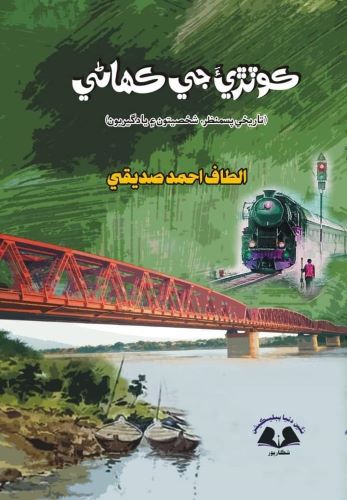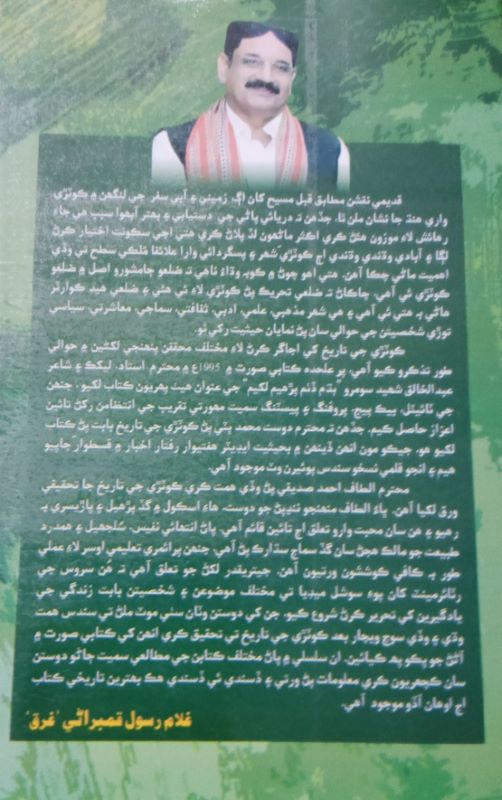
Kotri, situated on right bank of Indus River, has innumerable stories hidden in the annals of history
Nasir Aijaz
In March 1948, ‘The Naked City’, a film on New York City, produced by Jules Dassin, was released. The title of the film was taken from renowned American photographer Weegee’s 1945 collection of semi-documentary photographs. Later, Dassin’s film inspired the successful 1958-63 ABC TV series, on police investigation of a girl’s murder case, also known as The Naked City.
This write up is neither related to New York City nor the film or TV series titled as ‘The Naked City’, but solely to the film’s famous closing line- ‘There are eight million stories in the naked city – this has been one of them.’ I recalled this closing line while flipping the pages of newly published Sindhi book ‘Kotri’a Ji Kahani’ (The Story of Kotri), a historic city of Sindh, located at the right bank of River Indus. The book has been authored by Altaf Ahmed Sidiqui and published by Naeen Dunya Publications Shikharpur/Hyderabad and is available at Danyal Kitab Ghar Qasimabad Hyderabad.
What made me to quote the closing line of film is the introduction of the book, written by eminent author Yousif Sindhi. Commenting on the book, he writes, “While penning down the story of any city, the author must bear in mind that there are innumerable stories of the city hidden in the annals of history. These stories can be found in books, archival material as well as in the shape of oral history transferred by one generation to other. Every city has its own characters like that of humans. And, every locality of the city has also stories to dig out.”
Quoting the renowned BBC journalist Raza Ali Abidi, Yousif Sindhi says, “Like the human beings, every city has its own destiny – They take birth, flourish and face decay. Every city has several cities in its fold, like the Plato had stated centuries back that ‘Every city is composed of two cities – A city of rich and the other of poor.’”
“Kotri too is a city having countless stories,” Yousif says concluding that Altaf Ahmed Sidiqui has narrated in his book some of the countless stories of this historic city. “These stories are just glimpses.”
The book is in fact an anthropological study of Kotri, as it encompasses the historical background of the city, its old buildings, Churches, Mosques, Graveyards, tribes, castes, culture and the way of life of people who lived here through centuries
As had been stated of New York being the city of eight million stories, and introductory note of Yousif Sindhi, I believe that Kotri too is the city of million stories.
The book is in fact an anthropological study of Kotri, as it encompasses the historical background of the city, its old buildings, Churches, Mosques, Graveyards, tribes, castes, culture and the way of life of people who lived here through centuries. Being his native town, the author has also shared in the book his memoirs, which itself is a history that reflects the past and present of the city as Kotri has witnessed several changes since ancient days but also during the British colonial era as well as the post-partition decades.
 Altaf Ahmed Sidiqui, a former banker, has divided the book in three parts. The first part covers the historical background of Kotri, its geography, city during the British era, history of railways system, bridges, steam boats in River Indus, Kotri Barrage, mode of traveling before the railway system, historic graveyards, shrines, introduction of municipal system, tribes, Parsi graveyard, Christian cemetery, temples, revenue offices, cinemas, the abodes of transgender people, drug shops, sports and sportsmen, carpenters, photographers, hospitals, schools, singers and other artists, theaters, literary activities, industries and many more places and people.
Altaf Ahmed Sidiqui, a former banker, has divided the book in three parts. The first part covers the historical background of Kotri, its geography, city during the British era, history of railways system, bridges, steam boats in River Indus, Kotri Barrage, mode of traveling before the railway system, historic graveyards, shrines, introduction of municipal system, tribes, Parsi graveyard, Christian cemetery, temples, revenue offices, cinemas, the abodes of transgender people, drug shops, sports and sportsmen, carpenters, photographers, hospitals, schools, singers and other artists, theaters, literary activities, industries and many more places and people.
The second part of the book pertains to profile of prominent personalities of Kotri in the field of politics, literature, art, judiciary, journalism, government officials etc. The last and third part is based on author’s memoirs of half a century based on his observations.
The reader of this book would find several such interesting stories that very much justify to describe the Kotri as the city of million stories
The first chapter in the last part relates to political history of 1970 when the first general election was held after a long period of dictatorship in the country. Gen. Ayub Khan, who ruled the country for about 12 years, stepped down as a result of political pressure and handed over the power to Army Chief Gen. Yahya Khan on March 25, 1969, who announced holding of first ever general elections in the country. The elections for national assembly were held on December 7, 1970 and since Gen. Yahya had abolished the One Unit and old provinces were restored, the election for provincial assemblies were held on December 17, 1970.
Kotri, at that time was part of Dadu district, and therefore nationalist leader Saeen G. M. Syed contested the election from National Assembly (NA) Constituency 125, Dadu-II, where his opponent was PPP candidate Malik Sikandar Khan who won the election against G. M. Syed with a big majority.
The other chapters relate to educational system, his memoirs as student, Palla fish, old buildings, and old friends and how he observed the Kotri city.
As I had always been curious to know the meanings of the names of cities, I searched the background of the name Kotri. Interestingly, a small city with same name exists in Rajasthan state of India while I found the meaning of Kotri in English as a ‘bowl’. However, Altaf Ahmed Sidiqui says that no historical evidences could be found about the origin of name of the Kotri. He narrates some oral evidences according to which there existed a small ‘Kothri’ or a room at the bank of River Indus which later was called as ‘Kotri’. Some other statements said that the Kotri city was named after a ‘Kot’ or a fortress. He also quoted some local people who opined that since the city is situated in a low-lying area of Khirthar Mountain Range, two combined words formed the name Kotri and that are Koh (Mountain) and Tari (Bottom).
The reader of this book would find several such interesting stories that very much justify to describe the Kotri as the city of million stories.
________________
Nasir Aijaz is a senior journalist based in Karachi. He is author of nine books on history, literature and language including an award-winning book ‘Hur – The Freedom Fighter’.
[…] Read: Kotri – A City of Million Stories […]